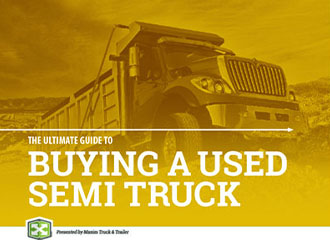20 Questions to Ask About Buying a Used Semi Truck
 After 15 years in the transportation industry, Kirk McCuspey has seen it all. The used truck sales manager at Maxim Truck & Trailer knows what to look for, whether it’s under the hood or in the fine print when researching a used truck.
After 15 years in the transportation industry, Kirk McCuspey has seen it all. The used truck sales manager at Maxim Truck & Trailer knows what to look for, whether it’s under the hood or in the fine print when researching a used truck.When you’re making a significant investment in transportation for your company, you need to arm yourself with as much information, such as a truck’s engine history and whether its regular maintenance appointments were kept as possible.
McCuspey believes an educated customer makes the best, most informed decisions for their company. There is no manual on how to buy a used truck but he hopes he can provide the next best thing by answering these 20 questions.
This Guide answers to most common questions customers ask about buying a used heavy-duty truck —and also includes questions they should be asking.
McCuspey believes an educated customer makes the best, most informed decisions for their company. There is no manual on how to buy a used truck but he hopes he can provide the next best thing by answering these 20 questions.
This Guide answers to most common questions customers ask about buying a used heavy-duty truck —and also includes questions they should be asking.
VIEW MAXIM'S USED TRUCK INVENTORY
H = Heavy Duty Trucks
M = Medium Duty Trucks
M = Medium Duty Trucks
| 1 | Does the truck have rear lock-ups? H When the first tandem trucks came out, the rear wheels would spin and the truck would jack knife. Having rear lock-ups keeps the tractor straight and you won’t have spin-outs when climbing mountains. The second life of a truck is usually a gravel or grain application, which is off-road and not on the highway. Drivers will go off-road into fields or push snow. With rear lock-ups, the truck can basically go through anything. |
| 2 | What's the engine's history? H M In the old days, unscrupulous sellers of trucks could roll back the odometer. Today, modern trucks come with an Electronic Control Module, or ECM, which talks to the engine and transmission to determine what the engine has done over its lifespan and whether it has ever over heated or been over-revved or over-idled. You can tell the engine hours and miles, all of the history can be pulled off the ECM. |
| 3 | What is the engine horsepower? H M The used truck buyer wants more horsepower than less. A common range is 410 to 435. If a farmer needs a truck for hauling grain or a gravel application, he’ll want 500 horsepower. The more horsepower you have, the less gear shifting you’ll do. On the highway, you’ll get better fuel economy with more horsepower pulling lighter loads. |
| 4 | Does the truck have a pre-emissions engine? H M A lot of second-life buyers want a truck that doesn’t have emissions on it. We’re slowly running out of those kinds of units, from 2007 and before, it’s harder to find that type of an engine. New technology can be challenging for a driver. New trucks come out and the drivers haven’t changed their habits and they’re having huge problems with the engines. One example is that today’s engines shouldn’t be idled. Idling plugs up the DPF filters. That can lead to huge bills at dealerships if the driver doesn’t watch the gauges. We have some trucks where the drivers have taped over the DPF filter warnings. The yellow light means the engine is starting to plug up. The red light means it’s getting really full and the blinking red light means the engine is shutting down. Check when the DPF was cleaned or replaced in proper application. They will last approximately 250,000 kms before cleaning, and about 500,000 kms before replacement. |
| 5 | Does the truck have air or hydraulic brakes? M This is important for a buyer of a five-tonne truck, who does pick-ups and deliveries in the city, like a furniture mover. You need an air endorsement to drive an air brake five tonne. With hydraulic brakes, anybody with a Class 5 licence can drive it. There is less maintenance on an air brake system. For one of our customers that does a lot of deliveries, a bottled water company, we paid for them to put their drivers through the air endorsements, saving them money on maintenance down the road. |
| 6 | Does the truck have an Allison Automatic transmission? M A Power Take Off (PTO) provision is for a truck’s second life. If it doesn’t have that gear within the transmission, you can’t put a dump box on it for gravel or grain. |
| 7 | Does it have a power tailgate? M Ninety-nine per cent of our 5 tonne trucks have power tailgates for deliveries. If you’re delivering to a place without a loading dock, you can put goods on the tailgate and use hydraulics to put it down or pick it up. |
| 8 | Does it have a walk board? M For 5 tonne trucks, if you’re carrying two or three boxes, it’s easier to roll out the walk board, a 16-foot aluminum board that goes straight to the ground. It’s important to have if you’re a furniture mover because nothing is palletized. Everything has to go up and down. If you had a tailgate, it would take you forever if every time you went to the truck, you had to put the tailgate up and down. |
| 9 | Does the box truck have any side doors? M If you have your load on the back of a box truck, you can access the front of the freight through the side door. |
| 10 | Is the back door roll-up or barn? M Barn doors on a truck open up just like on a barn and a roll-up door just slides up. With a barn door, you have to get out and open your doors before you back into a loading dock. With a roll-up, you just back in and then roll it up. |
| 11 | Are the wheels aluminum or steel? H Most drivers want aluminum wheels just for looks because they’re cleaner but there are weight savings if you have aluminum wheels. On a semi-truck, each steel wheel weighs 60 pounds while aluminum wheels weigh 25 pounds. It doesn’t seem like a lot but 35 pounds times 10 wheels is one-third of a tonne. Lighter wheels allow you to carry more payload. Aluminum wheels are $250 each and steel wheels cost between $80 and $100. Steel wheels can rust up, too. |
| 12 | Is there any rust on the frame or banjo housing? H The banjo housing is where the housing for your gears is located. It’s ridiculous to compare a truck from Eastern Canada with one from the West. In Ontario and Quebec, they pour salt on the roads. In the West, we plow them. You can tell if a truck is from the East as soon as you walk up to it. If it’s from the West, there’s no rust on the banjo housing. Some dealers sand blast the banjo housing to clean it up and make it look like it’s a Western truck but if you look under the hood, you can tell if there’s rust. Not very many buyers will look under the hood, they’ll look at the back end of the truck and say it’s from Western Canada. |
| 13 | Are the rear tire drives matching? H You don’t want different heights on your tires because your gears will wear out more quickly because of the slope of the axles. When we recondition a truck, most of them get a recap, which is the casing that’s been worn down. It’s a new tread on an old tire and it makes the tire as good as new. |
| 14 | Does the truck meet terms and conditions? H M That is an industry trade term that the customer will buy the truck meeting trade terms and conditions. There will be no broken glass, no tears or burns in the upholstery and anything like air conditioning or the stereo that was original with the truck will work. If we say, “there’s going to be 50 per cent rubber left,” that means the tires have at least 50 per cent or better tread depth left. |
| 15 | Does it have a double or a single bunk? H Having a sleeper berth is huge for highway tractors. This is important for husband and wife teams now. She’ll drive while the husband will sleep and vice-versa. A lot of carriers have two drivers so the truck doesn’t shut off. If you’re driving from Winnipeg to Toronto, one driver will do a 10-hour shift while the other driver is in the bunk sleeping and when the 10 hours is up, they’ll switch. A double bunk is huge in an application where you’ve got a long haul. |
| 16 | Is there any warranty remaining? H M On a one-year-old truck that we put into our rental fleet, we’ll buy the maximum amount of warranty available. We buy 800,000 km of warranty and if we can get it with turbo and water pump, we will. If it’s a four-year-old truck with less than 800,000 km on the odometer, it still has some warranty left. |
| 17 | Will you supply warranty? H M A lot of people will ask, “if the original equipment manufacturer’s warranty is expired, how long will you guarantee this truck will work for me?” We will help but we won’t pay for all the repairs. Every situation is different. Some guys come back after two months and say, “my cigarette lighter isn’t working.” We’re not going to fix that. If the clutch isn’t working, that’s not even covered on new trucks, so we can’t help you there. But if it’s using lots of oil for example, we’ll do a diagnostic test and help the customer. You can also buy a used truck warrantee that gives you piece of mind for big repairs. It’s an upfront cost that gives a used buyer more cost certainty. |
| 18 | Are there any maintenance files? H M This is a common request from people who are buying a used truck. They want to know our maintenance practices while we owned the truck. If we take a truck in a trade, we want to know when the engine was replaced or whether there was major transmission work. On our Maxim lease and rental units, we have the information right down to how many light bulbs have been changed. |
| 19 | Has it had a fresh service? H M When somebody buys a truck, they want fresh oil and fresh filters. That’s usually a $700 touch. When they come to test drive it, that work is already done. They know when they take possession that they’ve got 20,000 km to go before they need an oil change. |
| 20 | Is that your bottom line? H M We can always work with you, so throw us an offer. We try to keep it like a real estate deal, you give me an offer, we’ll counter it or accept it. |







